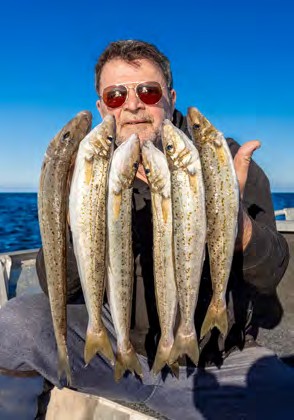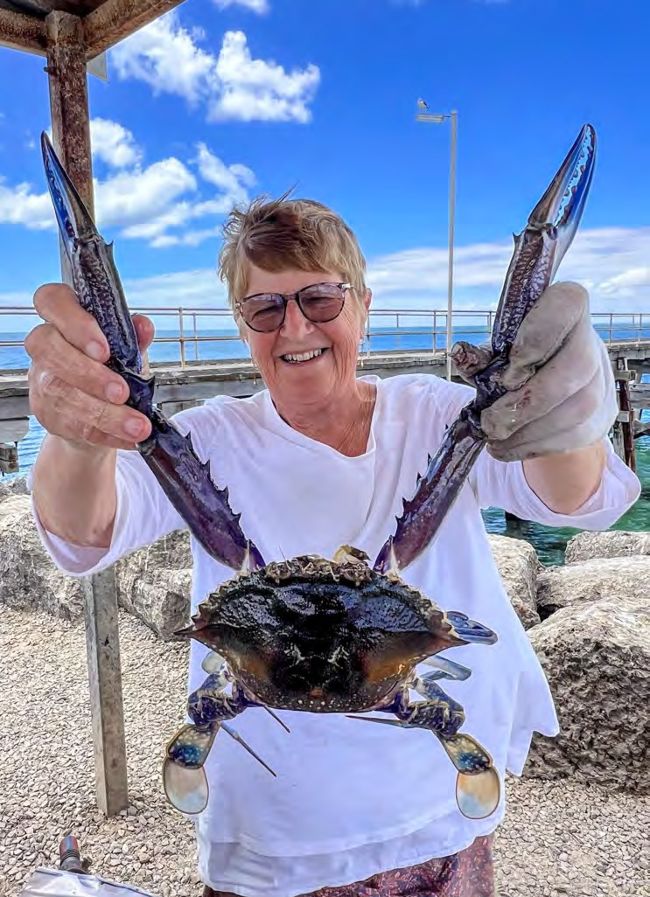THE ENIGMATIC BLUE SWIMMER

Shane Mensforth
Like most South Aussie seafood lovers, the succulent blue swimmer crab is right up there at the top of the list for me. I’ve been catching blueys for as long as I can remember – in just about every SA location they inhabit, and by every conceivable method. I’ve also caught them in WA, NSW and QLD, and plan to continue catching them for as long as I can pull a rope or wield a crab rake.
In our state the blue swimmer is a very significant target species for both the recreational and commercial fishing sectors. Nets, rakes and crabbing paraphernalia are big selling items in our tackle stores during the warmer months, and we all know how the commercial crabbing industry has exploded in recent times.
Blueys are easy to find, fun to catch and, of course, they are delectable on the plate; it’s a no brainer that their ongoing popularity is assured. I’ve always been intrigued by crabs’ life cycle, their habits and their movements – to the point that I’ve spent quite a bit of time lately speaking to experts and searching on Google to expand my knowledge base. I have noticed quite a few changes to SA’s blue swimmer population over the years, and it seems the more I delve into all of this, the more interesting it becomes.
Looking back to the 1980s and earlier, in Gulf St Vincent I can’t recall seeing blueys much further south than Brighton, but they are now on KI as well. On the western side of Spencer Gulf they are now as far south as Port Lincoln, and on the eastern shore they can be caught all the way down to Point Turton. On the western coast of Eyre Peninsula they have always been available around Ceduna and Streaky Bay, but now they are even present in Coffin Bay. No doubt there has been a noticeable expansion of the blue swimmer crab range state-wide, and that expansion shows little sign of slowing down.
Where I live, north of Port Vincent Yorke Peninsula, the average size of the summer/ autumn crabs has been pretty good this season. Since Christmas we’ve hardly had to measure a single bluey, and there have been quite a lot well over the 11cm minimum width. Back in 2021/2022 the average crab was as good as I’ve seen them here, but during the 2023/2024 season things were considerably different, with a 25 per cent throwback rate all the way through. Quite obviously, there are several factors in play when considering these seasonal variations, most likely water temperatures, food availability and, possibly, the amount of fishing effort.
The crabs in most areas – except for the southern waters of Spencer Gulf – seem to be a uniform size during the summer/ autumn ‘run’. Generally speaking, those caught off Adelaide are pretty close to the size of those from places like Streaky Bay,Port Broughton and Whyalla. However, once you head to Port Victoria or Point Turton on lower Yorke Peninsula, or Port Lincoln on lower Eyre Peninsula, things change dramatically.

A giant blue swimmer from Point Turton
We recently spent a few days caravanning in delightful Point Turton and decided to check out the local ‘super crabs’ I’d heard so much about. Although the bluey action wasn't exactly frantic, we managed 15 for the day, and each one was a monster. I didn’t measure any of our Turton crabs, but reckon they would have averaged 18-20cm across the carapace. They were all heavy and chock-full of meat, too. Malcolm Wheadon, who runs the Turton Caravan Park, told me that a few days before we arrived, he measured one crab that went an incredible 91cm from claw tip to claw tip. It was the biggest he had ever seen, and was obviously so old that it was carrying a few barnacles and small tufts of seaweed!
Directly across Spencer Gulf in Port Lincoln the crab situation is much the same. Proper and Louth Bays seem to be the most consistent producers of big blue swimmers, and their size is similar to the Point Turton giants.
According to reliable scientific data, blueys live for around three years and can top 25cm across the shell, so the lower Spencer Gulf crabs are certainly up there in the longevity stakes.
The question of why these XOS blueys aggregate in relatively small pockets is also intriguing. To find out, I spoke to a mate, Marty Nelson, who used to fish blue swimmers professionally, and now chases them recreationally for a feed. Marty has forgotten more about crabs and crabbing than most of us will ever know, and he offered some answers that make a good deal of sense. In his opinion, the monster crabs found in lower Spencer Gulf are no older than those we catch off Adelaide – they simply grow bigger because of the environment provided by these nutrient-rich pockets. Because of their territorial nature, their numbers in these locations aren’t as high and competition for food isn’t anywhere near the levels experienced further up the gulf. In short, there are less crabs per square kilometre, and their inherent territorial nature keeps it that way.
Whether they be monsters or just regular-sized crabs, I’m just glad to have them so readily accessible. And when it comes to my favourite crustacean on the plate, I definitely wouldn’t go past the good old blue swimmer to grab a plate of crayfish or prawns!